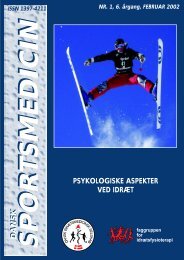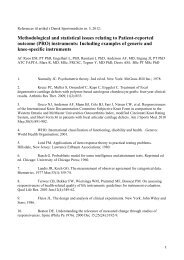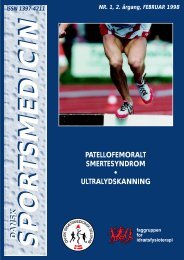Nr. 1/05 samlet - Dansk Sportsmedicin
Nr. 1/05 samlet - Dansk Sportsmedicin
Nr. 1/05 samlet - Dansk Sportsmedicin
Create successful ePaper yourself
Turn your PDF publications into a flip-book with our unique Google optimized e-Paper software.
the muscles show that T2-weigthed MRI scans may be applied to identify damaged<br />
muscles from which enzymes are being released into the circulation, indicating loss of<br />
sarcolemmal integrity. Furthermore, the reduced responses after the second bout indicate<br />
the presence of the “repeated bout effect”.<br />
6. CHONDRODYSPLASIA: A STUDY OF MATRIX CHANGES IN PATELLAR AR-<br />
TICULAR CARTILAGE OF A 14-YEARS OLD BOY<br />
Storgaard Peter1 , Nicolaisen Tom2 1 2 Interface Biotech A/S, Glostrup University Hospital, 2600 Glostrup; The Sports Clinic, Frederikssund<br />
Sygehus, Frederikssund, Denmark<br />
Introduction: Type II collagenopathies which relates to mutations in the gene encoding<br />
the type II collagen molecules, includes a genetically heterogeneous group of disorders<br />
with dysfunction of type II collagen hetero-fibrils during bone growth and maintenance<br />
of articular surfaces. In this study, we carried out LM ( light microscopy ) and TEM (<br />
transmission electron microscopy ) of articular cartilage and explant cultured chondrocytes<br />
from a 14-years old boy with severe articular lesions of the left patella. Material<br />
and methods: Loose articular pieces of cartilage were removed from patella during<br />
arthroscopy. From these fragments were cultured 2 weeks at 37C/5% CO2 as cartilage<br />
explants in _DMEM/F12 medium containing 15% FCS, antibiotic and ascorbic acid 2phosphate.<br />
The remaining pieces - as well as final cultured chondrocytes obtained<br />
from explant culturing - were processed for LM and TEM respectively. Discussion: LM<br />
and TEM of the cartilage showed a sparse and eroded extra cellular matrix (ECM) containing<br />
many empty and highly expanded lacunae involving the upper to lower cartilage<br />
zones. Within the ECM, type II collagen hetero-fibril aggregation and chondrocytes<br />
containing dilated rER with accumulated matrix proteins were identified. Matrix<br />
accumulation within rER was also demonstrated in explant cultured chondrocytes.<br />
Furthermore vesicles containing accumulated matrix proteins were identified intracellular<br />
and at the plasma membrane, suggesting impaired assembly and “aborted”<br />
secretion of aggregated matrix proteins to the ECM. Conclusions: Our findings indicate<br />
that type II pro-collagen were abnormally formed and accumulated within the rER<br />
of chondrocytes leading to collagen aggregates in a highly compromised ECM, together<br />
with dead chondrocytes. We suggest, that mutant type II pro-collagen are misassembled,<br />
secreted and incorporated into the ECM, where they exert a dominant negative<br />
effect on the function of type II collagen hetero-fibrils. We further suggest, that this<br />
phenotype is related to mutation(s) in the Co12A1 gene.<br />
7. JUMP HEIGHT IS RELATED TO DYNAMIC RATE OF FORCE DEVELOPMENT<br />
Jens Bojsen-Møller, Lars R. Rasmussen, S. Peter Magnusson, Michael Kjær, Per Aagaard<br />
Institute of Sports Medicine Copenhagen/Team Danmark Test Center, Bispebjerg Hospital, Copenhagen,<br />
Denmark<br />
Introduction: Isolated muscular function is frequently evaluated using isokinetic or<br />
isometric procedures, although the movement patterns do not resemble those of sports<br />
and/or daily life. It therefore seems desirable to quantify muscular performance during<br />
more functional motor tasks, such as those that include ‘stretch-shortening cycles’.<br />
It has been suggested that the ability to exert muscle force rapidly, i.e. the contractile<br />
rate of force development (RFD) is important for performance in high intensity muscle<br />
actions, however RFD has mainly been assessed during isometric conditions. The present<br />
study evaluated the day-to-day reproducibility of dynamic RFD measured during<br />
counter-movement jumping (CMJ), and investigated its relation to jump performance.<br />
Methods: Twenty-four male subjects performed six CMJ’s during standardized conditions<br />
on a force plate. Three similar test-days were completed. Maximal jump height<br />
(MJH) was determined by integration of the ground reaction force signal, and dynamic<br />
RFD was determined as the average slope of the force-time curve from the instant of<br />
peak eccentric velocity to +100ms. A Pearson product-moment correlation was computed<br />
to assess the relation between MJH and dynamic RFD. Day-to-day reproducibility<br />
was investigated for MJH and RFD by calculating r and CV for repeated measurements.<br />
Data are presented as means±SD. Results: MJH: 32.9±5.5cm (Day 2), and<br />
32.9±5.7cm (Day 3), r=0.97, CV=2.89%. Dynamic RFD: 1883±926N . s-1 . kg-0.33 (Day 2),<br />
and 1849±967N . s-1 . kg-0.33 (Day 3), r=0.82, CV=10.25%. MJH (32.9±5.7cm) correlated<br />
positively to dynamic RFD (1866±902 N . s-1 . kg-0.33), r=0.53, P















